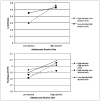Drinking, socioemotional functioning, and academic progress in secondary school
- PMID: 22556380
- PMCID: PMC5555848
- DOI: 10.1177/0022146511433507
Drinking, socioemotional functioning, and academic progress in secondary school
Abstract
Secondary schools are sites of academic instruction but also contexts of socioemotional development, and the intertwining of these two functions has consequences for adolescents' future health and education. Drawing on nationally representative data from the National Longitudinal Study of Adolescent Health (n = 8,271), this study explored the bidirectional associations among indicators of adolescents' alcohol use and their feelings of social integration at school. Socioemotional problems did not predict increased drinking over time, but drinking predicted declining socioemotional functioning, with negative implications for adolescents' academic grades by the end of high school. These associations, however, were conditioned by aspects of school context, with drinkers feeling more marginalized in schools characterized by dense networks with low rates of drinking.
Figures



References
-
- Arbuckle James L. Full Information Estimation in the Presence of Incomplete Data. In: Marcoulides A, Schumacker RE, editors. Advanced Structural Equation Modeling: Issues and Techniques. Mahwah, NJ: Lawrence Erlbaum; 1996. pp. 243–77.
-
- Aseltine Robert. A Reconsideration of Parental and Peer influences on Adolescent Deviance. Journal of Health and Social Behavior. 1995;3:103–21. - PubMed
-
- Aseltine Robert H, Gore Susan L. The Variable Effect of Stress on Alcohol Use from Adolescence to Early Adulthood. Substance Use and Misuse. 2000;35:643–68. - PubMed
-
- Bachman Jerald G, Wadsworth Katherine, O’Malley Patrick, Johnston Lloyd D, Schulenberg John. Smoking, Drinking, and Drug Use in Young Adulthood: The Impacts of New Freedoms and New Responsibilities. Mahwah, NJ: Erlbaum; 1997.
Publication types
MeSH terms
Grants and funding
LinkOut - more resources
Full Text Sources
Medical

